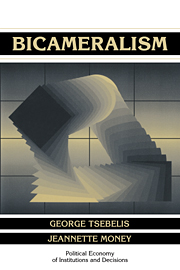Book contents
- Frontmatter
- Contents
- List of tables and figures
- Series editors' preface
- Acknowledgments
- Introduction
- PART I THE HISTORY AND GEOGRAPHY OF BICAMERAL DIVERSITY
- PART II MODELS OF BICAMERAL INSTITUTIONS
- Introduction to Part II
- 3 The core and the uncovered set of bicameral legislatures
- 4 A model of intercameral bargaining
- 5 A model of conference committees and their proposals
- PART III EMPIRICAL STUDIES OF BICAMERALISM AND IMPLICATIONS
- Conclusions
- References
- Index
4 - A model of intercameral bargaining
Published online by Cambridge University Press: 02 December 2009
- Frontmatter
- Contents
- List of tables and figures
- Series editors' preface
- Acknowledgments
- Introduction
- PART I THE HISTORY AND GEOGRAPHY OF BICAMERAL DIVERSITY
- PART II MODELS OF BICAMERAL INSTITUTIONS
- Introduction to Part II
- 3 The core and the uncovered set of bicameral legislatures
- 4 A model of intercameral bargaining
- 5 A model of conference committees and their proposals
- PART III EMPIRICAL STUDIES OF BICAMERALISM AND IMPLICATIONS
- Conclusions
- References
- Index
Summary
In the preceding chapter we argued that bicameralism stresses one dimension of conflict, the line connecting the centers of the yolks of each chamber. Here we take this finding for granted. We assume conflict along one dimension, either because there is only one policy dimension or because, on the basis of the previous argument, the two chambers are negotiating along line UL of Figure 3.6. This dimension represents the redistributive, or political, dimension of bicameralism described in Chapter 1.
In the following account we present complete and incomplete information models of bargaining. Complete information is the technical term indicating that the two players know each other's payoffs, while incomplete information indicates that some characteristic of one player is unknown to the other player.
Consider the lower house and the upper house as unified players and their ideal positions L and U on a particular bill. Along line segment LU, each house prefers a point that is closer to its own ideal point. Rubinstein (1982, 1985) developed the first bargaining model where two players divide an object between them – in this case, a dollar. One can think of the dollar as a unit segment with each player bargaining for the largest part. Our spatial representation of bargaining in legislatures is similar to the Rubinstein model; one difference is that, in the dollar model, each player is interested in obtaining the biggest possible part, while in our spatial representation, each player wants the smallest part. For reasons of mathematical convenience we will adopt the Rubinstein representation, where each player is interested in maximizing his or her share of the dollar.
- Type
- Chapter
- Information
- Bicameralism , pp. 98 - 109Publisher: Cambridge University PressPrint publication year: 1997



